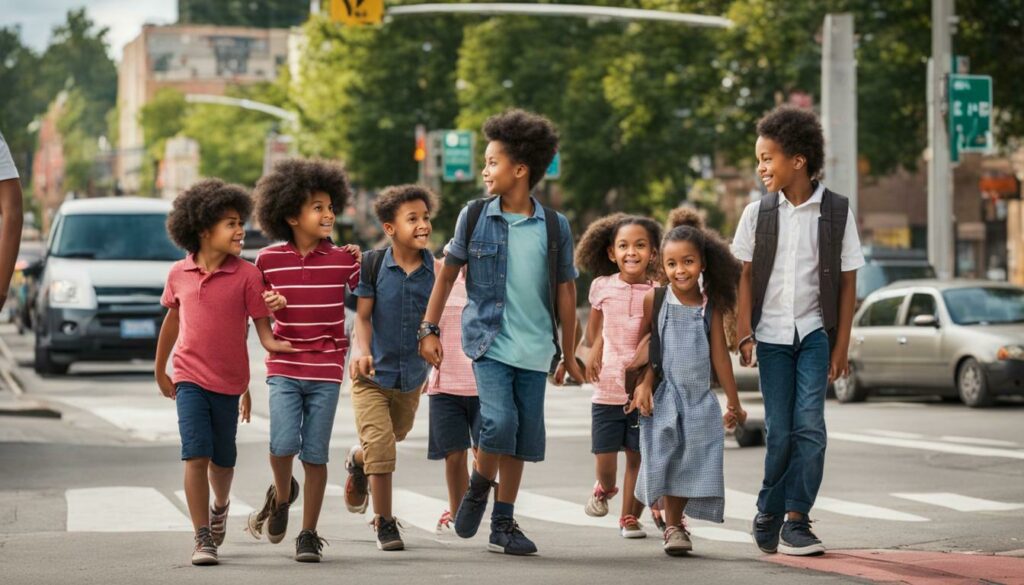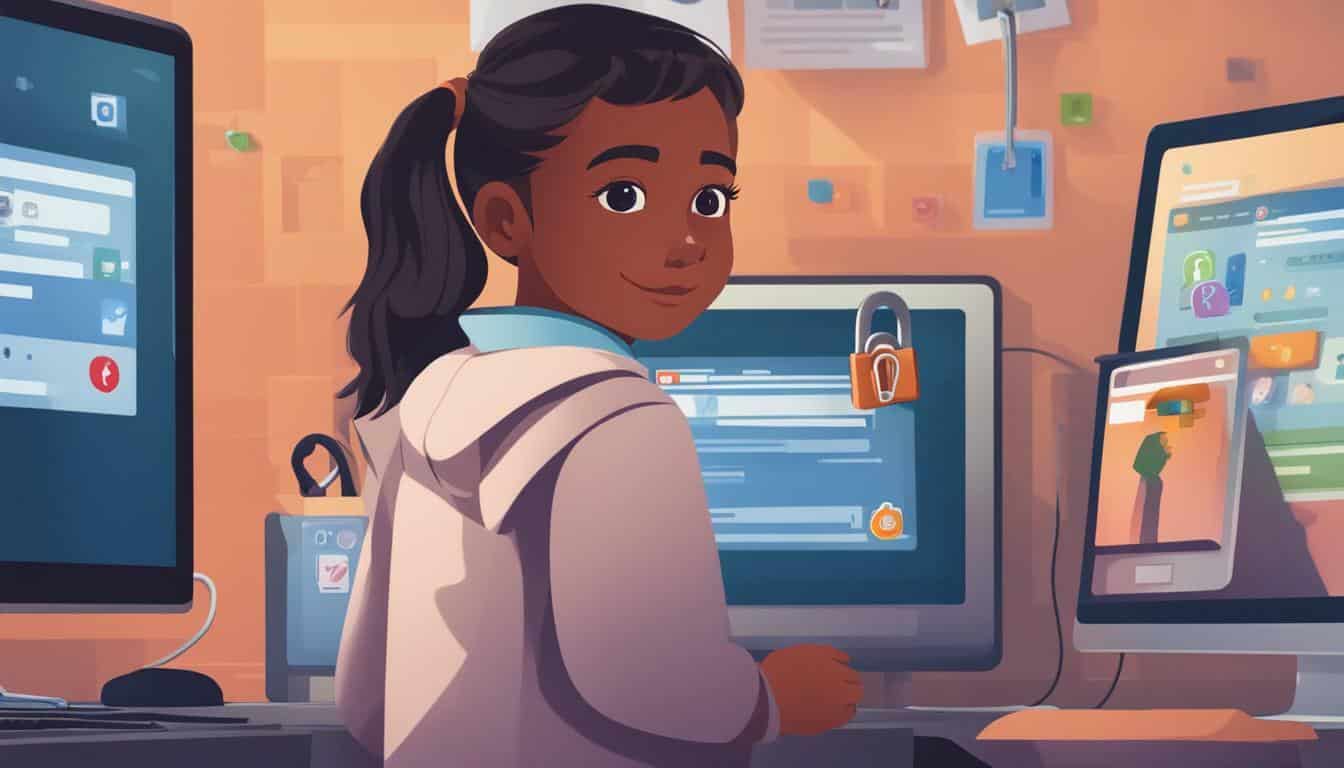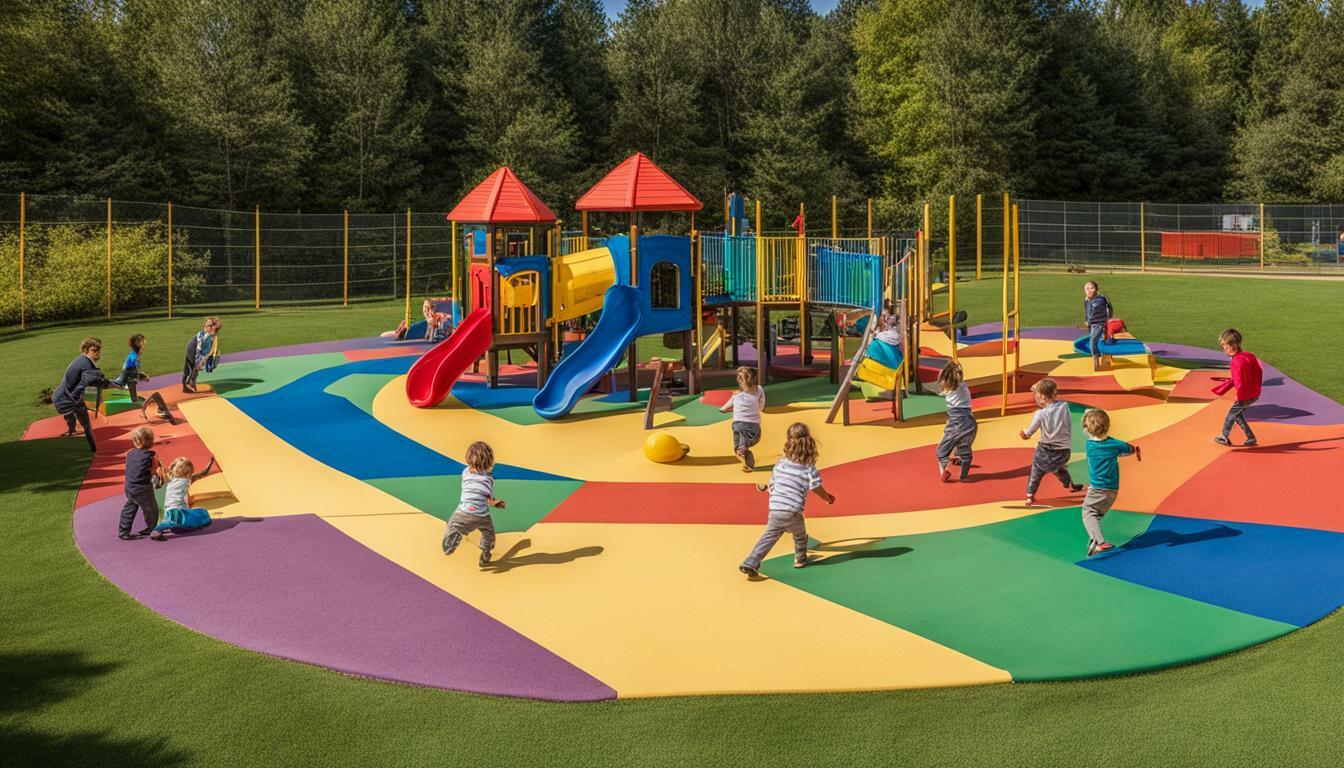Ensuring the safety of your children is a top priority, and teaching them about crime awareness is a paramount part of their protection. You can empower your kids to stay safe at home, school, and online by instilling the knowledge and skills to identify and steer potential dangers.
Key Takeaways:
- Crime awareness for kids is crucial for their safety and prevention.
- Teach children about the dangers they may encounter in their community and the importance of staying in groups and reporting suspicious activity.
- Create a safe home environment by installing smoke detectors, having fire escape plans, and keeping emergency kits readily available.
- Navigate school safety by addressing bullying peer pressure, and seeking help from trusted adults.
- Teach kids about online safety, including protecting personal information, avoiding strangers, and reporting any suspicious situations.
By following these child safety tips and teaching your children about crime awareness, you can empower them to make informed decisions, stay vigilant, and stay safe in various environments. Stay tuned for the upcoming sections that delve deeper into each aspect, providing you with practical advice and guidelines.
Understanding Dangers in the Community
In their journey towards crime awareness, children must understand the potential dangers that exist outside the comfort of their homes. Teaching kids about community safety is crucial to ensuring their well-being and empowering them to make safe choices. Here are some key points to consider:
- Staying in groups: Encourage children to always stay in groups when playing or walking in the community. There is safety in numbers, and being with friends or trusted adults can deter potential risks.
- Avoid talking to strangers: Teach children about the importance of not talking to strangers. Explain that even if someone seems friendly, it’s essential to maintain a safe distance and not engage in conversation.
- Reporting suspicious activity: Teach kids to trust their instincts and report any suspicious activity they observe. This could include unusual behavior, unfamiliar faces in the neighborhood, or any other signs that may raise concern.
By reinforcing these principles, children can confidently navigate their community safely and recognize potential dangers. Remember to have open conversations with your child about community safety and encourage them to ask questions or share any concerns they may have.
“Safety first is safety always.” – Charles M. Hayes
Here is a helpful table summarizing the key points to teach children about community safety:
| Key Points | Explanation |
|---|---|
| Staying in groups | Children should always play and walk in groups to enhance their safety and deter potential risks. |
| Avoiding talking to strangers | Children should never engage in conversation with strangers, even if they seem friendly. |
| Reporting suspicious activity | Teach kids to trust their instincts and report any suspicious behavior or unfamiliar faces in the community. |

By implementing these strategies and fostering a sense of community awareness, you can help prepare your child to stay safe and make informed decisions when they are outside the home.
Creating a Safe Home Environment
A secure and nurturing home environment is binding in educating children about crime awareness and ensuring their safety. By implementing simple safety measures, parents can create a space where their children feel protected and empowered, both physically and emotionally.
One of the fundamental elements of home safety is the installation and maintenance of smoke detectors. According to the National Fire Protection Association, having working smoke alarms decreases the chances of dying in a fire by 50%. Make sure to place detectors in every bedroom, outside sleeping areas, and on every level of your home. Test the alarms regularly and replace the batteries at least once a year.
In case of an emergency, having a well-prepared fire escape plan is crucial. Discuss and practice the plan with your children, ensuring they can safely exit the house. Consider drawing a simple map of your home, marking the escape routes and meeting points outside. Encourage your kids to memorize emergency contact numbers and teach them to dial 911 in case of an emergency.
Additionally, keeping emergency kits readily available is essential. These kits should include basic supplies like first aid items, non-perishable food, water, flashlights, and a battery-powered radio. Store the kits in easily accessible locations, such as a designated spot near the exit.
Creating a Safe Home Environment Checklist:
| Home Safety Checklist |
|---|
| Install and maintain smoke detectors |
| Create and practice a fire escape plan |
| Have emergency kits with necessary supplies |
| Ensure doors and windows are secure |
| Keep hazardous substances out of reach |
| Teach children about home security measures |
A safe home environment lays the foundation for crime awareness and helps children develop a sense of security, thereby empowering them to make informed decisions and protect themselves.

Remember, crime prevention starts at home, and by taking some simple steps, you can create a haven for your children. Stay tuned for the next section to explore school safety and how to navigate potential risks.
Navigating School Safety
As children spend significant time at school, educating them about crime awareness within this context is indispensable. Navigating school safety involves equipping children with the skills and knowledge to identify and handle potential risks such as bullying and peer pressure.
Bullying is a serious issue that can affect a child’s well-being. It is important to teach children how to recognize bullying behavior, such as verbal or physical abuse, and encourage them to report it to a trusted adult. By building open lines of communication, children are more likely to reach out for help when needed.
Peer pressure is another common challenge faced by kids in school. Children should be taught the importance of trusting their instincts and making independent decisions that align with their values and beliefs. Providing them with strategies and role-playing scenarios can empower them to assert themselves and resist negative influences.
By promoting a safe and inclusive environment, schools can play a crucial role in preventing and addressing these issues. Teachers and staff should be trained to identify signs of bullying and peer pressure, and take appropriate actions to intervene and support the affected students.
Key Points:
- Teach children to recognize bullying behavior and report it to a trusted adult.
- Empower children to trust their instincts and make independent decisions.
- Provide strategies and role-playing scenarios to help children resist negative influences.
- Schools should be proactive in creating a safe and inclusive environment.
“Bullying is a serious issue that can have lasting effects on a child’s well-being.”
| Bullying | Peer Pressure |
|---|---|
| Recognize bullying behavior (verbal/physical abuse) | Teach children to trust their instincts and make independent decisions |
| Encourage children to report bullying to a trusted adult | Provide strategies to resist negative influences |

Internet Safety for Kids
In today’s digital age, teaching children about online safety is paramount to crime awareness. With the internet playing such a significant role in our lives, educating kids about the potential dangers they may encounter online and how to protect themselves is crucial. By instilling good habits and teaching them to be cautious, we can empower children to navigate the online world safely.
One of the first lessons to teach children is the importance of protecting their personal information. Online predators can use personal information to target vulnerable children, so it’s essential to teach them never to share personal details like their full name, address, phone number, or school name with anyone they don’t know online.
Additionally, it’s important to teach children to be cautious when interacting with strangers online. Remind them that not everyone they meet online is who they say they are. Encourage them to only interact with people they know and avoid engaging in conversations or sharing information with strangers.

Parents can set strict privacy settings on social media platforms to ensure online safety further and supervise their children’s online activities. Parents must stay informed about the latest online trends, apps, and platforms their children use. Regularly discussing online safety with your child and maintaining an open line of communication can also help them feel comfortable reporting any uncomfortable or suspicious situations they encounter online.
By teaching children about online safety early on, we can equip them with the necessary knowledge and skills to protect themselves in the digital world. Parents can play a significant role in ensuring their children’s online safety through open communication, setting boundaries, and establishing healthy online habits.
Empowering Kids Against Crime
Empowering children to be proactive in crime prevention is a fundamental aspect of their overall safety. By teaching them child-friendly crime prevention activities, we can equip them with the knowledge and skills to protect themselves and make safe choices. These activities not only instill a sense of confidence and assertiveness but also help children develop critical thinking skills and the ability to identify potential risks.
One effective activity is role-playing scenarios. By acting out different situations, children can practice reacting and making safe decisions. For example, they can role-play encounters with strangers, learn to say “no,” and seek help from trusted adults. This interactive approach allows children to enjoy the material, ensuring better retention and application of the lessons learned.
Another valuable crime prevention activity for children is teaching them basic self-defense techniques. While we hope they never have to use them, learning how to protect themselves can boost their self-confidence and reduce their vulnerability. Encouraging physical activities such as martial arts or self-defense classes can provide children with practical skills while also promoting physical fitness and discipline.
| Crime Prevention Activities for Children |
|---|
| Role-playing scenarios |
| Teaching self-defense techniques |
| Instilling confidence and assertiveness |
Quotes
“Empowering children in crime prevention not only enhances their safety but also builds their resilience and self-esteem.” – Child Safety Advocate
Child-friendly crime prevention also involves fostering open communication with children. Encouraging them to speak up about any uncomfortable situations or encounters empowers them to take control of their safety. By listening attentively, offering support, and providing guidance, we can ensure that children feel heard and supported in their efforts to stay safe.
It’s considerable to remember that empowering kids against crime is ongoing. Regular conversations about personal safety, setting boundaries, and making safe choices should be a part of their upbringing. By equipping children with the necessary tools and knowledge, we can help them navigate potential risks and ultimately create a safer environment for everyone.

Educating children about gun safety and substance abuse prevention is integral to crime awareness and maintaining a safe environment. Teaching kids about the potential dangers of firearms and the importance of responsible behavior can help prevent accidents and tragic incidents. Additionally, instilling in children the knowledge and awareness about the risks and consequences of drug and alcohol use is crucial for their well-being.
When discussing gun safety with children, it is essential to emphasize the importance of never touching a firearm without adult supervision. Teach them that if they come across a gun, they should immediately inform a trusted adult and not attempt to handle it. Securely storing firearms in a locked cabinet or safe and keeping ammunition separate from the guns can help prevent unauthorized access.
In addition to gun safety, addressing substance abuse prevention is equally important. Educate children about the harmful effects of drugs and alcohol on their health, relationships, and future prospects. Encourage open communication and create a safe space where children feel comfortable discussing any concerns or peer pressure they may face. Teach them refusal skills and provide alternatives to risky situations, fostering confidence and assertiveness in making positive choices.

Parents and educators can equip children with the necessary knowledge and skills to make informed decisions and stay safe by incorporating gun safety and substance abuse prevention into crime awareness education. Open dialogue and a supportive and trusting environment are key in shaping responsible behaviors and helping children navigate potential dangers.
Using Common Sense and Street Smarts
Teaching children about common sense and street smarts is essential to their crime awareness journey. Parents and caregivers can empower kids to make informed decisions and take necessary precautions in different environments by instilling these skills from a young age. Here are some practical tips to help children stay safe:
- Trust your instincts: Teach children to listen to their gut feelings and trust their instincts. If something feels off or uncomfortable, encourage them to remove themselves from the situation and seek help from a trusted adult.
- Be aware of your surroundings: Teach kids to be observant and aware of their surroundings at all times. Remind them to look for potential hazards, observe people’s behavior, and stay alert.
- Avoid risky situations: Encourage children to avoid risky situations, such as going to unfamiliar places alone or accepting offers from strangers. Teach them to assess the potential risks and make safe choices.
Using common sense and street smarts is not about instilling fear but rather about empowering children to be proactive and responsible for their safety. By equipping them with these skills, parents can help ensure that their children are well-prepared to navigate potential dangers and make smart decisions.

“The best way to stay safe is to use your common sense. Trust your instincts and be aware of your surroundings. It’s important to teach children these skills so that they can make smart choices and protect themselves.” – Safety Expert
Summary:
In summary, teaching children about common sense and street smarts is crucial for their crime awareness and overall safety. By emphasizing the importance of trusting instincts, being aware of surroundings, and avoiding risky situations, parents can empower kids to be proactive and responsible. It is essential to educate children about these skills from a young age and provide them with the knowledge and tools to make informed decisions when faced with potential dangers.
| Key Tips | Benefits |
|---|---|
| Trust your instincts | Helps children recognize potential dangers and seek help |
| Be aware of your surroundings | Increases alertness and ability to assess potential risks |
| Avoid risky situations | Enables children to make safe choices and protect themselves |
Checklist for Ensuring Child Safety
To assist parents in educating and planning for their child’s safety, we have compiled a comprehensive checklist covering various aspects of crime awareness. By implementing these child safety tips, you can help protect your child from potential dangers and empower them with the knowledge they need to stay safe.
- 1. Home Safety: Ensure that your home is a safe environment for your child. Install and maintain smoke detectors, create fire escape plans, and keep emergency kits readily available. Regularly discuss safety protocols with your child to ensure they know what to do in case of an emergency.
- 2. School Safety: Teach your child about bullying and peer pressure and help them develop strategies for dealing with these challenges. Encourage open communication with teachers and school administrators, and empower your child to seek help when needed. Foster self-confidence and assertiveness to ensure your child can navigate school safely.
- 3. Online Safety: Educate your child about the potential internet risks and teach them to protect their personal information. Advise them not to share personal details online and to be cautious when interacting with strangers. Set clear guidelines for safe internet usage and consider using parental control software to monitor their online activities.
- 4. Community Safety: Teach your child the importance of staying in groups and not talking to strangers. Encourage them to trust their instincts and be aware of their surroundings. Emphasize the significance of reporting any suspicious activities to trusted adults, such as parents, teachers, or law enforcement.
- 5. General Safety: Promote the use of common sense and street smarts in everyday situations. Teach your child to trust their instincts, avoid risky situations, and make informed decisions. Encourage open communication and create a safe environment for your child to express any concerns or fears they may have.
By implementing these child safety tips and creating a crime awareness curriculum for your kids, you can actively protect them from potential risks. Remember, your child’s safety starts with you, and by arming them with the necessary knowledge and skills, you can help them navigate the world confidently and securely.
FAQ
Q: Why is crime awareness important for kids?
A: Crime awareness is crucial for kids to ensure their safety and prevention. By being aware of potential dangers at home, school, and online, children can learn how to protect themselves and make informed decisions.
Q: What are some tips for community safety for kids?
A: It is important for kids to stay in groups, avoid talking to strangers, and be vigilant about their surroundings. They should also report any suspicious activity to trusted adults or authorities.
Q: How can I create a safe home environment for my child?
A: To create a safe home environment, ensure working smoke detectors, develop fire escape plans, and keep emergency kits readily available. Educating your child about safety measures and involving them in discussions and drills is important.
Q: How can I help my child navigate school safety?
A: Addressing issues such as bullying and peer pressure with your child is essential. Encourage open communication, teach them assertiveness skills, and ensure they can seek help from trusted adults if they encounter any problems.
Q: What should kids know about online safety?
A: Kids should be cautious about sharing personal information online and avoid interacting with strangers. It is important to educate them about the risks and encourage them to report any suspicious or uncomfortable situations to a trusted adult.
Q: How can I empower my child against crime?
A: There are various activities and strategies to empower kids against crime. Try role-playing scenarios, teach self-defense techniques, and foster confidence and assertiveness in your child. The goal is to equip them with the knowledge and skills to protect themselves.
Q: How can I talk to my child about gun safety and substance abuse prevention?
A: Having open and honest conversations with your child about guns is important, emphasizing the importance of responsible behavior and secure storage. When discussing substance abuse, provide age-appropriate information about the risks and consequences of drug and alcohol use.
Q: What does it mean to use common sense and street smarts?
A: Using common sense and street smarts involves being aware of your surroundings, trusting your instincts, and avoiding risky situations. Teach your child to make informed decisions and take necessary precautions to stay safe in different environments.
Q: Can I use a checklist to ensure my child’s safety?
A: Yes, a comprehensive checklist covers various aspects of crime awareness and child safety. It includes home, school, online, and community safety tips, providing a practical resource for parents to refer to and educate their children about staying safe.










